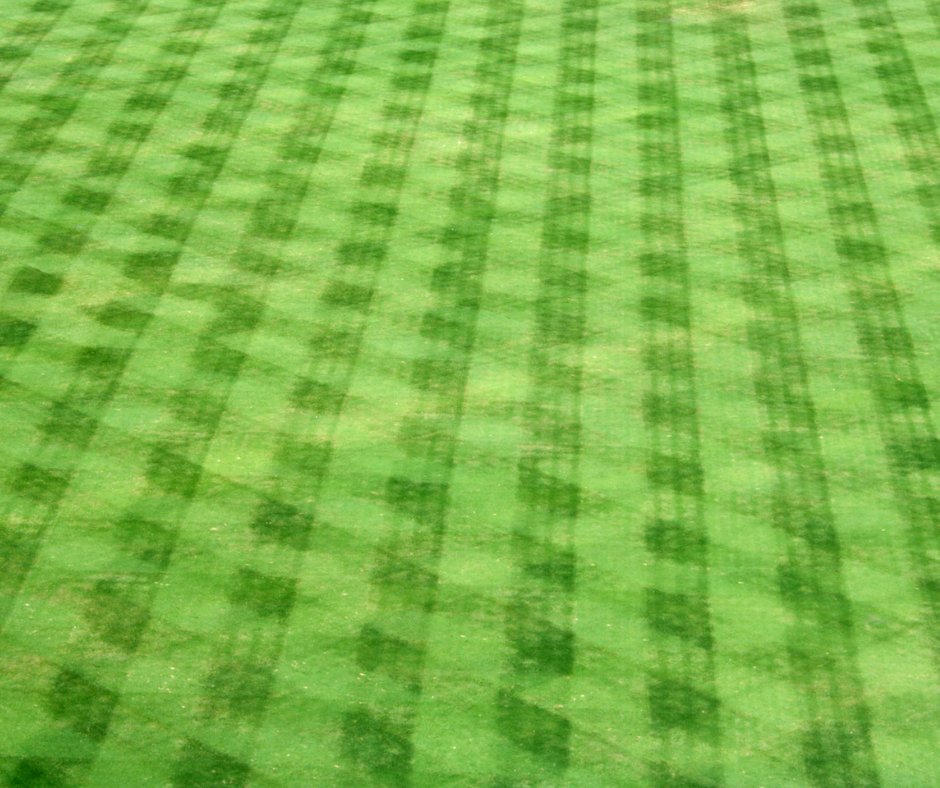How to Stripe your Lawn

There is nothing better than looking at your home accompanied with nice light and dark stripes in your front lawn. It raises the aesthetic of your home, possibly the resale value and makes you a target of unintended envy. On the golf course I have spent countless hours creating the perfect stripe and resultant patterns. It has been one of the most fun practices to do on a golf maintenance team and I will never get bored creating them. Showcasing a product is a pridefull practice that everyone should try.

Straight lines, diamonds, squares and contoured lines……..how is it done? Well, it all comes down to grass type and equipment. If you are in the situation where resodding or seeding your lawn is an occurrence you might want to consider this aspect before any purchase.
Striping your lawn does not just have a visual consequence, it also functions to keep your lawn smooth, dense and less prone to weed invasion. A dense sward is the number one guard against weeds; reducing any open bare soil patches and limiting sunlight to the soil surface are all factors that reduce weed instances. Competitive exclusion is aided by constantly manipulating the grass blades to grow into and fill voids.
Grass Wax Layer

Every plant has this, and it is called the cuticle. It’s the shiny or not so shiny outer layer of the leaf blade that helps prevent water loss. Warm season grasses like Bermuda grass do not have as thick a cuticle compared to Bluegrass and as a result doesn’t stripe up as well. This is because the cuticle is shiny and reflects sunlight; with less reflectiveness comes dimmer stripes. More effort therefore is needed to create a stripe. Mowing the same line 3 or 4 times may need to happen to get a similar result as mowing 1 pass on Bluegrass. Paspalums and Zoysias warm season grasses stripe up easier than Bermuda grass or St Augustine. Most cool season grasses stripe well with the least stripe-able being the tall fescue genus, not the fine fescue genus.
How to Stripe

The basis for creating stripes is to push the leaf blades in one direction with a mower pass and then to counter the previous line with an opposite adjacent pass. Creating diamonds or squares would be multiple mows at 90 degrees to previous pass and less if you want diamonds. The best way to get a straight line is to start out by picking a point at the intended end of your line and focus on that point at the beginning, during and at the end of the mowing pass. This ensures that you are not focused directly in front of the mower which leads to wandering and s-shaped passes. If you intend to contour mow and go with your lawns’ flow, then start at one smooth flowing edge of your lawn and work across following the previous line. All are fun to create and are satisfying to look at afterwards.
What Machinery Do I Need?

If you are using a cylinder mower then you are good to go already, the drive roller is your implement that will create the lines. Small rotary mowers can be fitted with a roller attachment that is pulled behind the mower in order to create a stripe. Most hardware stores have roller options and they cost about $100. If you are using a lawn tractor, then your main option would be to get a tow behind roller that attaches to your tractor hitch and these cost from $100 to $200.
Zero turn mowers can be fitted with a solid roller to the back of the mowing deck only if the deck is side eject and not rear eject. These cost around $200 and up.
Of course, you can stripe up somewhat without a roller and rely on the turning of your rotary blade to create a line, just not to the same extent as with a roller. Overall, this is one of the most pleasing tasks to be completed on your lawn.
Tags
© 2023 LaPageBrands, LLC. All rights reserved.

